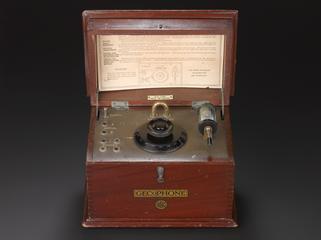
Billi condenser used for aerial tuning in Newfoundland, 1901
- Made:
- 1901 in Chelmsford
- maker:
- Marconi Company Limited

Billi condenser, or adjustable receiving capacitor, used for tuning the aerial in Newfoundland for the first wireless communication across the Atlantic, probably made by Marconi's Wireless Telegraphy Company, Chelmsford, Essex, England, December 1901.
In December 1901 Guglielmo Marconi claimed to have received wireless telegraphy signals in Newfoundland transmitted across the Atlantic from Poldhu in Cornwall, UK. Because no inked record could be made of the received signals, commentators were initially sceptical until Marconi achieved something very similar in front of independent witnesses a few months later. The billi condenser is an early form of adjustable capacitor. It is so named because its capacity is in the order of a billifarad. They are said to have been used for tuning the receiving aerial in Newfoundland. This was suspended from balloons and kites after the fixed aerial masts were destroyed in a gale. Whether they were actually in the aerial circuit when the signals were heard is difficult to judge because the detector eventually used required an untuned circuit.
Details
- Category:
- Radio Communication
- Object Number:
- 1923-434/9
- Materials:
- copper (alloy), cardboard and thread
- Measurements:
-
overall: 180 mm 46 mm, .067 kg
- type:
- radio component
- credit:
- Donated by the Institution of Electrical Engineers




